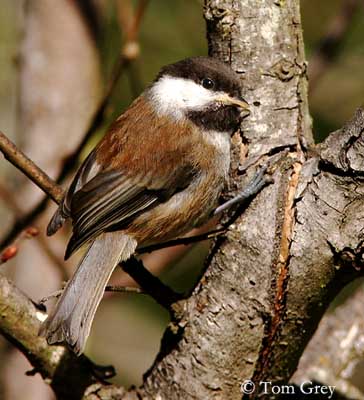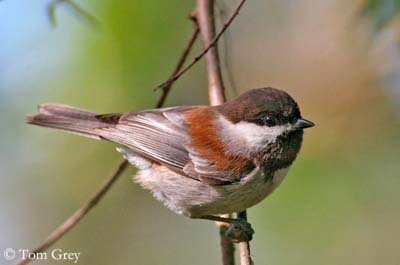
Chestnut-backed Chickadee
Poecile rufescens
Passeriforme Order – Paridae Family
BIOMETRICS:
Length: 11, 5 – 12, 5 cm
Weight: 8, 5 – 12, 5 g
Race “barlowi” displayed here.
DESCRIPTION:
Chestnut-backed Chickadee is a bird of the Pacific coast of North America. This species is the smallest of the New World chickadees.
Both adults are similar.
Adult has bright chestnut upperparts and lesser upperwing coverts. Secondary coverts are tipped greyish-white. Uppertail coverts are olive-brown.
According to the range, underparts show bright chestnut flanks (N San Francisco) or greyish flanks (S San Francisco). Belly is dull whitish.
PROTECTION / THREATS / STATUS:
Chestnut-backed Chickadees are common locally in several parts of the range. Populations are increasing and extending the range, thanks to the increase of some tree’s species such as Douglas fir of genus Pseudotsuga.
This species is not threatened at this moment.
Fr: Mésange à dos marron
All : Rotrückenmeise
Esp : Carbonero Dorsicastaño
Ital : Cincia dorsocastano
Nd : Bruinrugmees
Sd : Rostmes
Photographs by Tom Grey
Tom Grey's Bird Pictures
Text by Nicole Bouglouan
Sources :
HANDBOOK OF THE BIRDS OF THE WORLD Vol 12 by Josep del Hoyo-Andrew Elliott-David Christie - Lynx Edicions - ISBN: 8496553423
All About Birds (Cornell Lab of Ornithology)
The Birds of North America online
What Bird-The ultimate Bird Guide (Mitchell Waite)

Head is black and white, with black crown, nape, chin and throat. Cheeks are white, extending below the eye to the nape.
The slender, pointed bill is black. Eyes are dark brown. Legs and feet are blue-grey.
Juvenile is duller than adults.
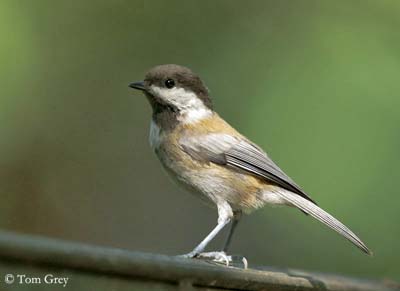
We find three subspecies:
P.r. rufescens occurs in Alaska, SW Canada and W USA, southwards to California coast. This race has bright chestnut flanks extending to the rump into darker tinge.
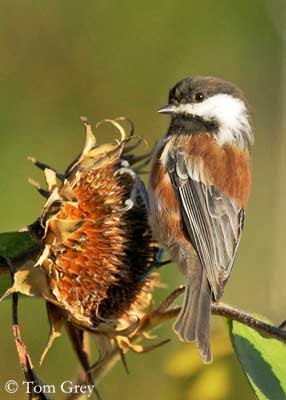
P.r. neglectus is found in coastal C California. This race has duller chestnut flanks, and paler back and rump.
Since 1990s, “rufescens” is moving into the range of “neglectus”, involving the disappearance of the latter.
P.r. barlowi occurs in SW California (S from the Bay). This race has greyish to pale olive-brown flanks and undertail coverts, but there is a small dull chestnut area on lower flanks. Back and rump are duller than in “rufescens”.
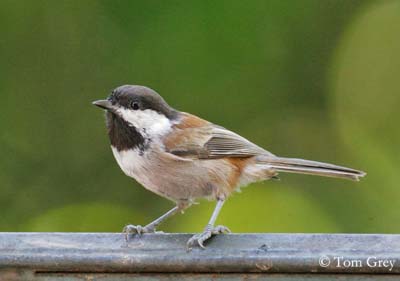
VOICE: SOUNDS BY XENO-CANTO
Chestnut-backed Chickadee’s calls include “tsidi-tsidi-tsidi-cheer cheer” and some variations. It also utters deeper and slightly harsher “dee-dee-dee-dee” when the bird becomes aggressive.
This species utters high, buzzy notes and others lower and nasal, or more metallic, some chirruping “chlit-chit”, “dzvi” and “seezi”, and musical “swi-swi-swit” running into longer phrases.
The song is a series of “chip” notes on single pitch “chip-chip-chi-chi-chi-chip”.
There are dialects and individual variations in their repertoire.
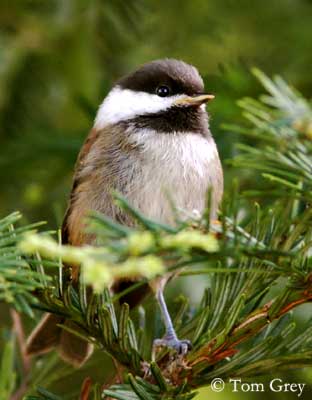
HABITAT:
Chestnut-backed Chickadee frequents forested areas such as dense conifer forests, including several trees’ species, plantations, ornamental trees (eucalypts and cypresses) in suburban areas.
This species favours woodland edges and river borders.
It is usually seen below 900 metres of elevation, but in some parts of the range, up to 1700 metres in Sierra Nevada and more in Idaho.
RANGE:
Chestnut-backed Chickadee is largely resident in its range, from Alaska southwards to California coasts.
There is a small population in W Rocky Mountains in S British Columbia, S Alberta and W Montana.
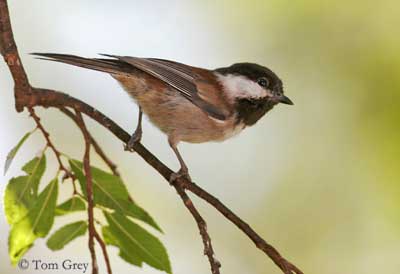
BEHAVIOUR:
Chestnut-backed Chickadee feeds on small invertebrates and larvae of several species, and fruits and seeds outside the breeding season.
They forage in pairs or flocks of up to 20 birds, and sometimes in mixed-species foraging flocks.
This bird is very active and adopts some acrobatic postures when foraging. It gleans among the leaves and hangs from twigs and branches. It rarely feeds on the ground and prefers to forage in canopy and upper level in trees. It may pursue flying insects in flight.
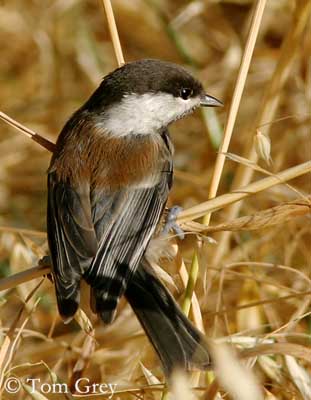
Chestnut-backed Chickadee is resident in its range. Some of them perform altitudinal movements and post-breeding dispersion to higher elevation in late summer and early autumn.
Chestnut-backed Chickadee is noisy when foraging in mixed flocks, or announcing the establishment of the territory.
Some displays are performed in “Poecile” group, with exaggerated postures such as head-up displays indicating the male’s health and fitness. They also perform courtship feeding, with the male providing the most part of the food to the female, giving her the largest preys that it catches before the egg-laying.
Chestnut-backed Chickadees are monogamous, and seem to be paired for life or at least for several seasons.
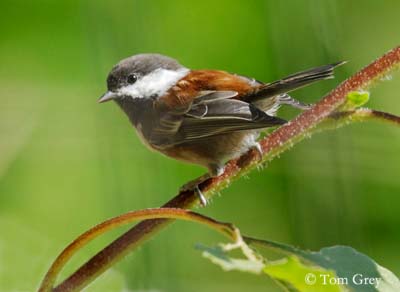
FLIGHT:
Chestnut-backed Chickadee performs weak fluttering flights of short duration.
REPRODUCTION:
Breeding season occurs from mid-March to end June.
Chestnut-backed Chickadee is territorial. This species may occasionally nest in loose colonies of up to 7 nests.
The female builds the nest in cavity in tree, stump or dead branch. The hole may be excavated by the pair, or adapted from some natural cavity. An abandoned woodpecker’s hole may be used too. The site is often reused during several years. The nest is made with moss, hair or fur, plant fibres and feathers, at about 5 metres above the ground.
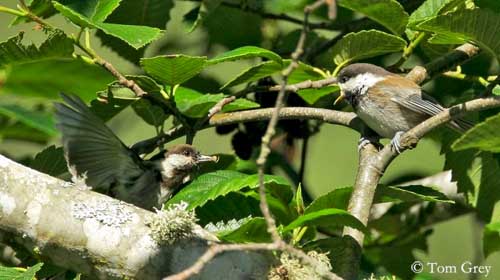
Female lays 6-8 eggs, and incubates during about 12-14 days. Chicks are fed by parents and fledge 18 to 21 days after hatching. They reach their sexual maturity at one year.
DIET:
Chestnut-backed Chickadee feeds mainly on invertebrates and larvae such as moths, aphids, leafhoppers and hymenopterans. It also takes spiders and crickets.
They consume fruits and seeds outside breeding season.
